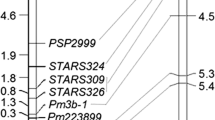Abstract
The maize inbred lines 1145 (resistant) and Y331 (susceptible), and the F1, F2 and BC1F1 populations derived from them were inoculated with the pathogen Pythium inflatum Matthews, which causes stalk rot in Zea mays. Field data revealed that the ratio of resistant to susceptible plants was 3:1 in the F2 population, and 1:1 in the BC1F1population, indicating that the resistance to P. inflatum Matthews was controlled by a single dominant gene in the 1145×Y331 cross. The gene that confers resistance to P. inflatum Matthews was designated Rpi1 for resistance to P. inflatum) according to the standard nomenclature for plant disease resistance genes. Fifty SSR markers from 10 chromosomes were first screened in the F2 population to find markers linked to the Rpi1 gene. The results indicated that umc1702 and mmc0371 were both linked to Rpi1, placing the resistance gene on chromosome 4. RAPD (randomly amplified polymorphic DNA) markers were then tested in the F2population using bulked segregant analysis (BSA). Four RAPD products were found to show linkage to the Rpi1 gene. Then 27 SSR markers and 8 RFLP markers in the region encompassing Rpi1 were used for fine-scale mapping of the resistance gene. Two SSR markers and four RFLP markers were linked to the Rpi1 gene. Finally, the Rpi1 gene was mapped between the SSR markers bnlg1937 and agrr286 on chromosome 4, 1.6 cM away from the former and 4.1 cM distant from the latter. This is the first time that a dominant gene for resistance to maize stalk rot caused by P. inflatum Matthews has been mapped with molecular marker techniques.





Similar content being viewed by others
References
Byrne PF, McMullen MD, Snook ME, Musket T, Widstrom NW, Wiseman BR (1995) Quantitative genetic analysis of loci controlling synthesis of maysin, a corn earworm resistance factor, in maize silks. Maize Coop Newslett 69:53–54
Chen SJ, Song TM (1999) Disease resistance of maize stalk rot–simple genetics controlled by single gene. Acta Chin Agric Univ 4:56
Christensen JJ, Wilcoxon RD (1966) Stalk rot of corn. American Phytopathological Society, St. Paul, Minn
Dias AP, Braun EL, McMullen MD, Grotewold E (2003) Recently developed maize r2r3 myb genes provide evidence for distinct mechanisms of evolutionary divergence after duplication. Plant Physiol 131:610–620
Jim S (1999) Common stalk rot disease of corn. Plant Dis 6:1–8
Lander ES, Green P, Abrahamson J, Barlow A, Daly MJ, Lincolin SE, Etoh J (1987) Mapmaker: an interactive computer package for constructing primary genetic linkage maps of experimental and natural populations. Genomics 1:174–181
McCouch SR, Kochert G, Tu ZH, Wang ZY, Khush GS, Coffman WR, Tanksley SD (1988) Molecular mapping of rice chromosome. Theor Appl Genet 76:815–729
McMullen M, Simcox KD (1995) Clustering of disease resistance loci in the maize genome. Maize Coop Newslett 69:52–53
Pe ME, Gianfranceshi L, Taramino G, et. al. (1993) Mapping quantitative trait loci (QTLs) for resistance to Gibberella zeae infection in maize. Mol Gen Genet 241:11–16
Stack RW, Elias EM, Joppa LR (1999) Fusarium head blight reaction of durum wheat lines conditioned by Triticum dicoccoides chromosome substitutions. Phytopathology 89(Suppl):S74
Tesfaye T, Larry EC, Mitchell RT (2004) Estimation of combining ability for resistance to Fusarium stalk rot in grain sorghum. Crop Sci 44:1195
Thon MR, Nuckles EM, Takach JE, Vaillancourt LJ (2002) CPR1: a gene encoding a putative signal peptidase that functions in pathogenicity of Colletotrichum graminicola to maize. Mol Plant Microbe Interact 15:120–128
Toman J, White DG (1993) Inheritance of resistance to anthracnose stalk rot of corn. Phytopathology 83:981–986
Wu QA, Zhu XY, Lin HX, Jin TJ, Wang GY (1997) Methodological study on the isolation and determination of infectious ability of the pathogen for maize stalk rot. Plant Pathol 27:29–35
Yang DE, Chen SJ, Wang YG (2000) Genetic analysis of resistance to stalk rot (caused by Pythium inflatum Mattews) in maize. Chin Acta Phytopathol 28:392–396
Yang DE, Zhang CL, Wang YG (2002a) Review of maize stalk rot in China. J Maize Sci 1:4–6
Yang DE, Zhang CL, Wang YG (2002b) Study on the Rfg1 (resistance to Fusarium graminearum Schw) in maize. Acta Agron Sinica 28:129–133
Yang DE, Zhang CL, Zhang DS, Jin DM, Weng ML, Chen SJ, Nguyen H, Wang B (2004) Genetics analysis and molecular mapping of maize (Zea mays L.) stalk rot resistant gene Rfg1. Theor Appl Genet 108:706–711
Zhang CL (2000) Molecular biological analysis of maize stalk rot resistant gene. Ph.D. thesis. Institute of Genetics, Chinese Academy of Sciences
Acknowledgements
This work was supported by the 10th Five-Year Research Program of Science and Technology in China (2001BA511B04) and the State Key Basic Research and Development Plan of China (2001CB108802). The maize RFLP probes were kindly provided by Professor Ed Coe (University of Missouri, Columbia, Mo., USA). The strain Pythium inflatum Mattew was kindly donated by Professor Xiaoming Wang, Chinese Academy of Agricultural Sciences. All maize seeds were JPEGts from Professor Song Tongming, China Agricultural University
Author information
Authors and Affiliations
Corresponding author
Additional information
Communicated by R. Hagemann
Rights and permissions
About this article
Cite this article
Yang, D., Jin, D., Wang, B. et al. Characterization and mapping of Rpi1, a gene that confers dominant resistance to stalk rot in maize. Mol Genet Genomics 274, 229–234 (2005). https://doi.org/10.1007/s00438-005-0016-5
Received:
Accepted:
Published:
Issue Date:
DOI: https://doi.org/10.1007/s00438-005-0016-5




